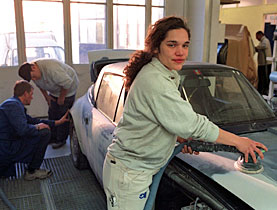Government pushes gender equality scheme

Women in Switzerland have made important advances in the past two decades, according to the Federal Statistics Office.
In a report issued to coincide with the 20th anniversary of the Federal Gender Equality Office this week, it says that many more women are now in employment, their level of education is rising, and they are playing a greater role in politics than was the case in 1988.
The principle of gender equality was added to the Swiss constitution in 1981, but the law on equality only came into effect in 1996. Nevertheless, as the federal office admits, there is still a long way to go in achieving real equality.
According to the Statistics Office, women still earn far less than men. It says that 60 per cent of the differences in pay can be explained by objective factors, including breaks in employment for family reasons, which mean that women have less experience and seniority in their jobs. But the remaining 40 per cent has to be regarded as discrimination.
Wage differentials vary considerably from one job to another, but are present in both the public and private sectors, and at all wage levels and irrespective of the demands of the job or the qualifications required.
Help on the way
On the occasion of its anniversary, the gender equality office has launched a new scheme to help enterprises promote equal opportunity among their staff. Differences in pay are only one aspect to be covered.
Money will be made available to help enterprises develop their own projects.
“The scheme is directed at all aspects of work relationships,” the federal office director, Patricia Schulz, told swissinfo.
“Wage equality is naturally a big element, but the reconciliation of family and work is also very important. There’s also things like the possibly of further training, distribution of work between men and women, job sharing including in top positions, part time jobs, and so on.”
The main target is enterprises with up to 500 staff, she explained. Potentially a lot of employers could be involved, since the scheme covers not only private enterprises but also administrations at canton and commune level.
The Federal Gender Equality Office website stresses the many advantages that firms gain from offering equal opportunities to their employees.
“They become more attractive for qualified staff, their rate of staff turnover drops, their innovation goes up and they acquire a progressive image,” it says.
Among the help offered by the new scheme is support for enterprises which want to check their pay systems or other aspects of their employment policy to find out how they measure up to the ideal of equal opportunities.
Schulz cited as a further example the provision of child care. Many women do not work full time after starting a family because there is no one to care for their children. While the scheme will not fund company crèches, it could help employers to decide the best way to provide facilities themselves.
Men’s jobs, women’s jobs
Despite the progress that has been made over the past 20 years, the distribution of jobs between the sexes has changed little.
Men are still more likely to choose technical subjects, like engineering, architecture and information technology, while women greatly outnumber men in health care, social work and school teaching, figures released by the Statistics Office show.
For Schulz there is no intrinsic reason why this should be so and she believes it is an issue that has to be addressed.
“So far nobody has been able to prove that it’s because of nature that women are stuck in low-paid jobs with few chances of getting to the top!”
“We are still faced with the weight of the past, and the past was very clear: men do certain activities, women do other activities,” she said.
She pointed out that in the early days of primary schools, the teachers were all men, and it was a fight to get women accepted in this profession.
“This has changed, and I think what has changed is the prestige and the salary (in relative terms) has gone down.”
At the other end of the teaching scale, the proportion of women teaching at university level has doubled in the past ten years, from seven to 14 per cent, thanks to a plan for equal opportunities.
“When you remove the obstacles you see that… we don’t get stuck in so-called biological reasons,” she pointed out.
The ball is now in the employers’ court to remove as many obstacles as possible.
swissinfo, Julia Slater
The office is part of the interior ministry.
It has nine full-time jobs, but works closely in cooperation with third parties.
It is currently focusing on the two areas of employment and family, taking into account the perspectives of both sexes.
The initiative was approved by the government in the spring of 2008.
The pilot scheme was launched on November 3, to coincide with the Federal Gender Equality Office’s 20th anniversary. It will run until 2016.
Every year about SFr1,000,000 will be available to help enterprises improve equality of opportunity for their employees.
Those eligible to apply are private enterprises and administrations at canton and commune level.
The enterprise must itself provide at least half the financing for its project.
The deadline for applications is March 31, 2009.

In compliance with the JTI standards
More: SWI swissinfo.ch certified by the Journalism Trust Initiative



You can find an overview of ongoing debates with our journalists here. Please join us!
If you want to start a conversation about a topic raised in this article or want to report factual errors, email us at english@swissinfo.ch.